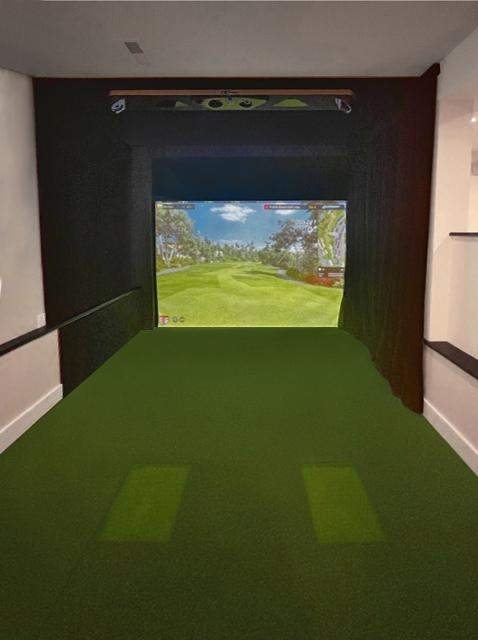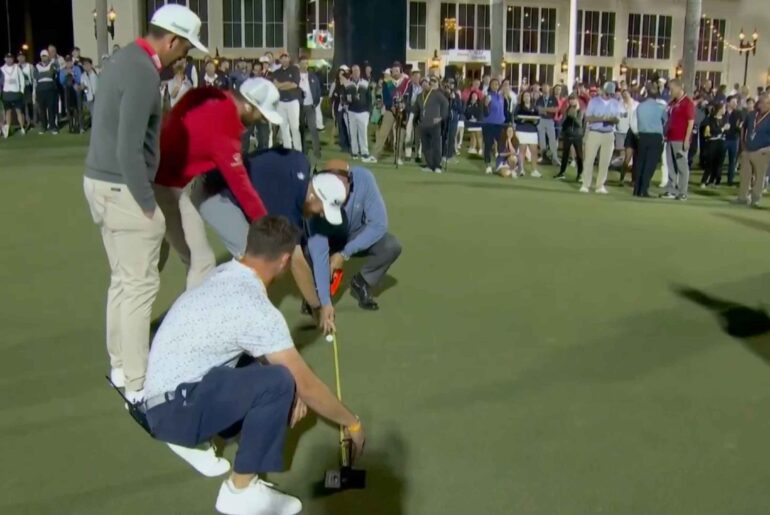What is the smallest space you can comfortably install a golf simulator into?
John Viera
During COVID, John Viera of Saline, Mich. decided to repurpose some unused space in his basement. With limited room, he figured he’d convert it into a pinball arcade. Then a contractor showed up to give an estimate for finishing off the area, and suggested that Viera might instead use it for a golf simulator.
“I thought that would be awesome,” recalls Viera. “But being it was a traditional basement, it had a seven-and-a-half-foot ceiling, right down to the joists. So I didn’t think I could do it. And the guy said he knew a company that could break the concrete and dig down. Another issue: the area was only 10 feet wide by 15 feet long. I started Googling about installing a simulator in a house, and it said you really needed a 13-to-15-foot minimum width, because of the equipment placement. Figured I was screwed and wouldn’t be able to put one in. Then I was talking to a golf pro at our country club and he told me to call Ace Indoor Golf down in Toledo, as they install a lot of simulators and maybe there’s something they could do.”
Lucky for Viera, simulator veteran Brett Heringaus answered the phone at Ace. He was able to work with the contractor to dig the floor deeper so that Viera had a 10-foot height, and figure everything out size-wise by positioning the equipment properly. Viera did not want a portable launch monitor unit that he’d have to move around for righties and lefties. Ultimately he decided on a unit from Foresight Sports that could be placed in front of the golfer – and could accommodate righties and lefties. “I honestly thought it was not going to happen because everything I saw online talked about big spaces you needed,” says Viera. “But Brett showed me the light and made it happen.”
Sometimes golfers want a simulator so bad that they don’t consider the space size. Deneen Zaetta of Rumson, N.J. approached Ace about installing a sim in her basement. But it was the Ace people who initially questioned the room size. ”They would have loved a little bit more space,” she says. “They were a little concerned about lefties and righties having equal amount of space. Fortunately, we’re mostly righties here, so it worked out pretty well. We saw another sim locally and thought the space was similar to ours. The only thing we were concerned about was keeping it safe from errant balls leaving the enclosure.” Zaetta ultimately used retractable drapes for that.
For simulator companies, figuring out how to maximize tight spaces is an everyday thing. Joe Neumeyer, co-founder of Ace, has seen his share of people trying to cram a full-sized sim into a small space in their home, over the past 20 years.
“I’ve put them in a dining room, living room, an attic space, next to a water heater in a utility room – outside of a bathroom or kitchen, I’ve done just about every other room,” he says. “Space size is key. The narrowest you can probably get away with is about nine feet, depending on if the technology is off to the side or the back, or overhead. But that’s probably what you need width-wise for a safe swing clearance – otherwise you’re gonna feel like you’re hitting the wall behind you. If you’re a right-handed golfer, you have about two feet of clearance to the right. So you don’t want to feel like you’re gonna hit the wall on the right hand side either if you toe or shank one. Height depends on the golfer and swing. There’s no minimum height, other than what you feel comfortable with. Any of the ground launch monitors don’t care what the height is. They capture the shot data from the ground in the first three feet of ball flight, to display your shot on the screen. As for your physical height, it’s more an issue of how high that club goes up in the air at the top of your backswing. Plus you need about 14 feet in length, if you’re hitting into a screen. Our motto is, if you can swing a club, you can fit our sim in – as long as you feel comfortable. I want people to enjoy the experience. If you’re always worried about hitting the ceiling or hitting the back wall, it’s not enjoyable.”
And that’s why you should definitely consult an expert before installing one in your home. After all, simulators are expensive. But if the right one works well in your space, it’ll add plenty of enjoyment and value to your home.







